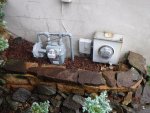tonype
Senior Member
- Location
- New Jersey
Gas and electric meters in a "pit" made from stones...
In addition to the meter being hidden/too close to grade and too close to the gas meter, are there any other concerns with respect to electric (such as being buried by snow?)?
In addition to the meter being hidden/too close to grade and too close to the gas meter, are there any other concerns with respect to electric (such as being buried by snow?)?




 to safeguard persons and property from hazards arising from the use of electricity?
to safeguard persons and property from hazards arising from the use of electricity?